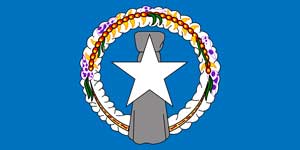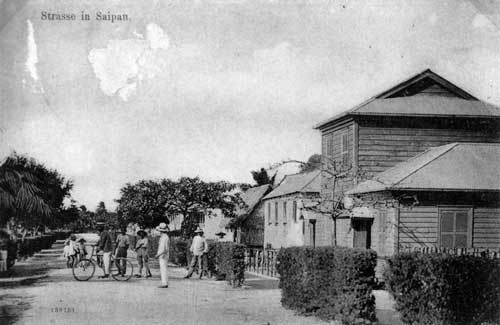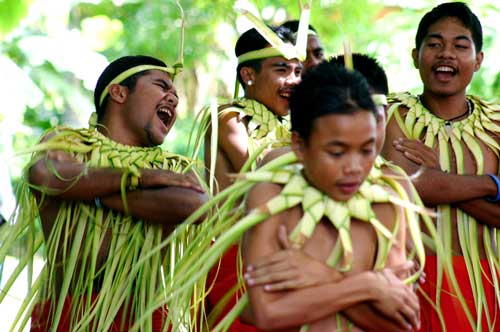Map
Flag

Quick facts
Official Name: Commonwealth of the Northern Marianas
Indigenous Peoples: CHamoru and Carolinian (Refaluwasch)
Official Languages: CHamoru, Carolinian and English
Political Status: Commonwealth of the United States
Capital: Capitol Hill, Saipan
Population: 52,344 (2015 est)
Greeting:
CHamoru: Hafa adai,
Carolinian: Tirow wami
History and geography

The CNMI is composed of 22 islands and islets in the western Pacific. The commonwealth is a part of the Mariana Islands, a chain of volcanic mountain peaks and uplifted coral reefs. The Marianas chain also includes the politically separate United States unincorporated territory of Guam, to the south. Saipan (46.5 sq mi or 120 sq km), Tinian (39 sq mi or 101 sq km), and Rota (33 sq mi or 85 sq km) are the principal islands and, together with Anatahan, Alamagan, and Agrihan, are inhabited. Another island, Pagan, was evacuated in 1981 after a severe volcanic eruption, though people still live there on and off. The capital of CNMI is in Saipan.
Some 4,000 years ago, the Marianas were settled by people from Island Southeast Asia who were known for their navigation skills and as the builders of latte, capstone pillars that held up houses and community buildings.
Portuguese navigator Ferdinand Magellan was the first European to arrive in the Marianas when he stopped briefly on Guam in 1521. In 1565, Miguel López de Legazpi landed at Humåtak, Guam, and proclaimed Spanish sovereignty over the “Islas de las Ladrones” (Islands of Thieves) or “Islas las Velas Latinas,” (Islands of the Lateen Sails) – the name given to the islands by Magellan. The permanent colonization of the islands began with the arrival of the Jesuit priest Diego Luis de San Vitores in 1668. He renamed the islands the Mariana Islands in honor of his benefactor, Queen Mariana. Over the next two decades, many islanders were killed in the process of resettlement to Guam. Others died from the rapid spread of disease in the settlements, thus further decreasing the population.
Groups of Carolinians, who refer to themselves as the Refaluwasch, from the outer islands of Chuuk and Yap, settled in Saipan in the 1800s after their home islands were devastated by natural disasters. CHamorus eventually were allowed to move back to Saipan and Tinian in the mid-1800s as well.
After losing the Spanish-American War of 1898, Spain sold the northern islands to Germany in 1899, and Guam became a possession of the United States. The Germans had little impact on CHamoru and Carolinian culture, though they did introduce new forms of education, bureaucracy, infrastructure and governance. In 1919, after Germany’s defeat in World War I, Japan administered the Mariana Islands (except for Guam) and most of the rest of Micronesia under a mandate from the League of Nations.
Throughout the Japanese period, the CHamorus remained semi-isolated from the Japanese. Intensive agricultural development in copra and then sugarcane was carried out largely by thousands of Japanese nationals and imported labor from other Japanese colonies. Education and other trappings of modernization enhanced some aspects of CHamoru life, and some CHamorus look back on that period as a golden age of economic prosperity and stability. However, other than an acquired taste for imported rice, little that was Japanese remained after the brutal battles on Saipan and Guam in 1944.
In July 1947, the Northern Marianas was recognized as part of a United Nations Trust Territory administered by the United States, beginning a period of American acculturation and modernization. The traditional Hispanic-CHamoru culture was infused with American economic and political energy. Tourism and the reopened markets on Guam encouraged the people of the Northern Marianas to look beyond their island borders, setting the stage for economic growth.
In 1978, after years of debates and plebiscites, the Northern Marianas entered into a commonwealth association with the United States. Though still under foreign control, the new Commonwealth of the Northern Mariana Islands reintroduced in modern form a measure of autonomy missing from CHamoru culture for over four hundred years.
Currently, tourism is the biggest economic driver of the Northern Marianas.
Arts and culture

There is a lively arts scene in the Marianas, including dance, music, crafts, cooking, storytelling and theater. The Flame Tree Arts Festival celebrates local culture, food and artists. The April event takes place over three days on Saipan. Attendees can enjoy local artwork, dancing, music and other special activities.
